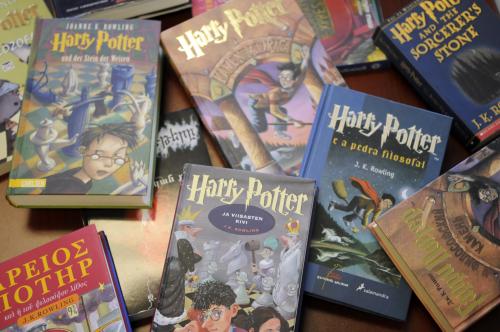I honestly had some difficulty in picking a topic for this week’s blog post. Don’t get me wrong, this lesson provided great topics like culture: organizational and structural, values, Hofstede’s dimensions of culture, and cultural gaffes all of which are worth discussing. But having never traveled outside of the United States and having limited interactions with people of different cultures, I found myself really struggling to personally relate to these terms (and providing a top of conversation different from my discussion post). As an avid reader, I have chosen to instead relate the term ethnocentrism, which as defined in our commentary is the “exaggerated tendency to think the characteristics of one’s own group or race is superior to those of other groups or races” (PSU World Campus, 2015), to the series Harry Potter by J.K. Rowling. This series is available in 73 languages, and has sold over 450 million copies worldwide (USA Today, 2012). While in an unconventional manner, the idea of ethnocentrism is mentioned several times in the text, though the exact terminology is not stated.
To explain the text for those who have not read it, the series chronicles the life of a young wizard named Harry Potter and how he fights evil. This evil comes in many forms and is often not something he purposefully seeks to thwart, he simply is trying to do what he believes is right. One major character who Harry fights is Lord Voldemort, whose ideas epitomize the term ethnocentrism. Lord Voldemort believes that those who are “Purebloods” (both parents are wizards) are better than those who have come from non-magical families to the point he believes anyone who does not share his culture should die. Many wizards follow this feeling and look down upon other’s who don’t share their same decent. In fact in the first book of the series, “Harry Potter and the Sorcerer’s Stone” the foil to Harry’s character, Draco Malfoy says: “I really don’t think they should let the other sort (children from non-magical/ mixed magical families) in, do you? They’re just not the same, they’ve never been brought up to know our ways.” (Rowling, 1998). Here we see a boy of 11 expressing superiority to other’s his age, and in the context of the book children he had never met before. This is a constant theme throughout the book: teasing, bullying, and even murdering someone based on ethnicity stemming from ethnocentrism.
It can be quite jarring to think that someone if 11 can hold these views, but that is the reality when values such as these are picked up from home. As stated in the commentary “Values tend to be formed in the beginning of life” (PSU World Campus. 2015). At home Draco Malfoy was taught that he was better because he was a “Pureblood” wizard. He, his family, Voldemort, and others of the same culture lased out of those who they believed were lesser because “Values determine behavior” (PSU World Campus, 2015). The fact that these beliefs lead to violence and discord in the series show how dangerous ethnocentrism can be and how it relates to interactions with others of different ethnicities and cultures.
So how is Harry Potter significant to global leadership? The idea that we need to approach people who are different from us with respect has been laid out in 73 different languages available around the world for children to read and learn from during their formative years. Author J.K Rowling had essentially taught the perils of ethnocentrism to those too young to know the term or even pronounce the word. J.K Rowling profoundly states in her book Harry Potter and the Goblet of Fire, ““Differences of habit and language are nothing at all if our aims are identical and our hearts are open.”(Rowling, 2000). By means of these books children and adults alike are learning that cultural differences mean nothing if were are willing set them aside and work toward a common goal, something essential of a global leader.
(photo credit: https://arts.ucalgary.ca/artsnow/learning-languages-harry-potter)
USA Today. (2012, September 25). Retrieved January 23, 2015, from http://www.usatoday.com/story/life/books/2012/09/25/j-k-rowling-harry-potter-the-casual-vacancy/1582921/
Rowling, J. (1998). Harry Potter and the sorcerer’s stone. New York: A.A. Levine Books
Rowling, J. (2000). Harry Potter and the goblet of fire. New York: Arthur A. Levine Books.
Pennsylvania State University World Campus (2015). OLEAD 497B Lesson 02: Introduction to Culture. Retrieved from https://courses.worldcampus.psu.edu/sp15/olead497b/001/content/02_lesson/01_page.html


This was a great example of ethnocentrism in a way that I had not though to look at it before. This difference in groups gives a great deal of insight to how often we think ourselves to be superior to one another. Being that this takes place subconsciously it is no wonder that it is even tied into the behavior of the Harry Potter characters. Perhaps it is so common, that it is widely accepted without us even thinking about it. It just goes to show that being aware can transcend the worst of behaviors and we can overcome the many obstacles that it may cause.